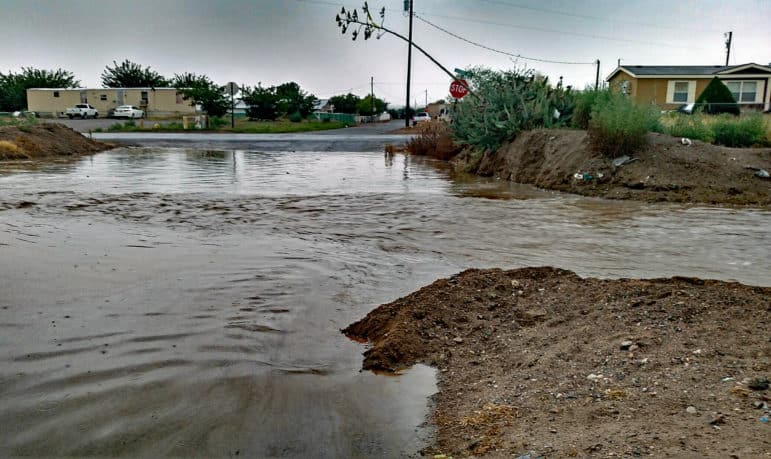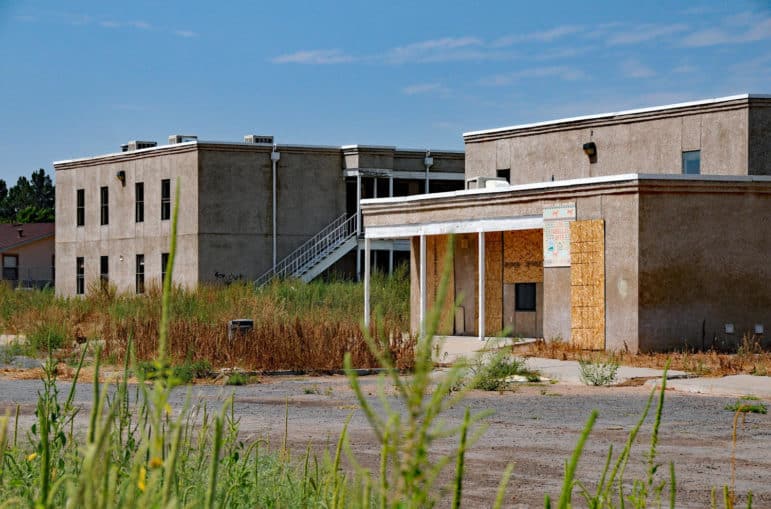
Courtesy photo
Heavy rains caused flooding in the northern Doña Ana County community of Salem this summer. Salem doesn’t have the population density to qualify for federal dollars for flood-control infrastructure.
Flooding in the Paso del Norte region and New Mexico this long monsoon season cannot be compared to the disasters upending Texas, Florida and Puerto Rico. Yet heavy rains have impacted numerous communities, even claiming a pair of lives.
In a tragedy that made national news, Silver City floodwaters were blamed for the deaths of James “Chamo” Morales, 47, and Laura Madero, 57, a.k.a, Laura Ortega, when the vehicle the two were riding in was swept into an arroyo early on the morning of Sept. 29, according to the Silver City Sun-News. The newspaper reported that Morales was a relative of N.M. state Senator Howie Morales, who described the flood victim as a “talented” tile man, Harley Davidson lover and humorist.
“The one thing that was unique about him was his voice,” Morales was quoted as saying. “You always knew when he was around.”
Laura Madero “loved her customers at La Familia Restaurant and enjoyed getting to know the community of Silver City,” read an obituary posted at legacy.com. Both Morales and Madero left behind large families scattered across the Southwest.
Government studies, media reports and personal accounts from late July to the first week of October detail blinding storms; pounding hail; flooded streets, homes and yards; dozens of temporarily evacuated residents; strained or overwhelmed flood control systems; and temporary highway shutdowns in the New Mexico counties of Doña Ana, Grant, Valencia, Bernalillo and Sandoval, among others.
Similar events were recorded in neighboring El Paso County, Texas, where Canutillo, Socorro and parts of the city of El Paso experienced inundations and property damages.
Numerous events consisted of intense but relatively short rainstorms — breaking records for precipitation measurements in some instances, and of the type climate scientists predict will become more common as the earth heats up.
According to NASA, “Projections of future climate over the U.S. suggest that the recent trend towards increased heavy precipitation events will continue. This trend is projected to occur even in regions where total precipitation is expected to decrease, such as the Southwest.”
This reporter experienced two such events over the summer. In El Paso, heavy rain pummeled a geographically limited area early one August evening around downtown El Paso and the lower part of Mesa Street, trapping cars on the road and forcing the cancellation of a Chihuahuas baseball game. Up Mesa, however, only a few drops watered the pavement.
A few days later in Albuquerque. torrential rain showered the southeastern quadrant of the city one afternoon, flooding streets near the airport and saturating storm drains.
Grappling with a changing climate
Flash flooding, of course, is nothing new in the region, but scientific studies point to increasing dangers.
“As the climate changes, or however that turns out, these kinds of things are going to become more and more of an issue,” Doña Ana County Flood Commission (DACFC) Acting Director John Gwynne told this reporter in response to a question about changing rainfall patterns. “We’ve been trying to look into that and see how it affects us.”
Gwynne’s department and other agencies recently have had their hands more than full. On Sept. 28, for instance, the sprawling community of Chaparral, which had suffered a road-blocking sinkhole from July rains, was struck by renewed flooding after about three inches of rain fell over a couple of hours, according to Gwynne.
Another serious event occurred July 24 on the northern end of Doña Ana County in the village of Hatch, when a downpour led to the temporary evacuation of about 40 people from their homes. Subsequently, the Red Cross, fire departments, Elephant Butte Irrigation District and county agencies mobilized to aid the victims and repair damages. Heavy machinery rolled on the ground and drones deployed overhead for assessment purposes.
Jorge Rodriguez was visiting Hatch and forced to “shelter in place” at the Pic Quick store for “10-15 minutes” while the storm pounded the small rural community. “Visibility was zero to none,” Rodriguez recalled.
Coming as it did in the thick of the growing season of Hatch’s iconic chile crop, the heavy rain prompted worries among farmers about possible crop losses.
As this year’s Hatch chile festival approached, grower and seller Pete Atencio knocked on wood that flooding would not resume. Besides the immediate damage storms can produce, too much water favors the dreaded root disease in the soil that spells disaster for farmers.
“We had a pretty good scare with the rains, but it’s looking good,” Atencio said in an interview at his store in downtown Hatch. The veteran farmer estimated that about 15 percent of fields he was aware of had the root rot, but no greater problems had developed.
For growers like Atencio, losing crops prior to the Labor Day weekend chile festival is comparable to retailers having no goods on the shelves during the Christmas shopping season.
The days surrounding the chile festival are “the busiest time of the year,” Atencio said. “There’s a big demand for (chile). Nobody’s complaining about not selling.” Visiting chile lovers from California, Arizona and Colorado stoke the local economy, he added.
Gwynne said the July 24 flood originated between the flood-prone Spring Canyon and problematic Placitas Arroyo — in a place bereft of flood control protection and, notably, in “an area that’s not had an issue” in the past.
In August 2006, the Placitas Arroyo overflowed into the center of Hatch, displacing hundreds of people and reaping about $2 million in property damage. More than 11 years later, damaged properties are still visible in the self-proclaimed Chile Capital of the World. Strikingly, the old Caballo Apartments, once the home of farmworker families, stand empty amid overgrown weeds, splattered graffiti and boarded-up windows.

Heath Haussamen / NMPolitics.net
Damaged by flooding in 2006, the old Caballo Apartments in Hatch, once the home of farmworker families, stand empty amid overgrown weeds, splattered graffiti and boarded-up windows.
According to the Gwynne, the DACFC is working with the U.S. Army Corps of Engineers and other government agencies on flood control initiatives in Spring Canyon, where construction of a new dam is proposed to begin in 2019, and the Placitas Arroyo — as well as a study of the zone where the July 24 event happened.
Located about six miles north of Hatch, the farmworker community of Salem was also affected by this summer’s flooding. A former resident of Salem, Jorge Rodriguez said flooding has been an ongoing issue in a community split by an arroyo. Frequently clogged with debris, the arroyo spills water onto the properties of residences hugging the embankment, mainly mobile homes.
Salem is a recognized colonia by the U.S. Department of Housing and Urban Development, one of numerous communities in the U.S.-Mexico border region defined by underdeveloped infrastructure. Gwynne described Salem as falling into a bigger countywide pattern of residential development running up against historic rural realities. “We’re growing. As we grow, we’re growing more into the unincorporated areas,” he said. “We’re running into farmlands.”
In Salem’s case, the community is downstream from two old dams that were constructed to protect farmlands and not “sized” for residential flood protection, he said. Gwynne’s agency is developing a flood control plan for Salem that includes building an intercepting channel to route water into a retention pond. “It allows us to meter out the water at a controlled rate,” Gwynne said.
The price of flood control in one county
Among about three dozen colonias in Doña Ana County, Salem’s flood vulnerability is far from unique. At the request of County Commissioner Billy Garrett, the county government released a colonias infrastructure report last month that detailed specific projects for upgrading and protecting the developing communities. According to the report, slightly less than half of Doña Ana County’s 209,000 people live in colonias or surrounding rural areas.
And the price tag for needed infrastructure isn’t cheap. Ignoring improvements, however, entails other costs.
According to the report, “Substandard conditions impede public safety, discourage economic investment, and limit job opportunities. Inadequate wastewater systems increase the risk of aquifer contamination, and insufficient storm-water systems expose entire communities to catastrophic loss.”
Although 24 “recognized dams” provide flood hazard mitigation to the colonias, “most of these structures are at or beyond their design life,” the report states. For the dams to stay “functional,” an investment of $216 million, “plus or minus $24 million,” is necessary, according to the report’s authors.
Other costs identified in the report include DACFC drainage master plans carrying an additional $133 million in expenses. That brings the preliminary bill for colonia flood protection and control in the ballpark of $349 million in Doña Ana County alone.
But the overall expenses for colonia flood control go higher if modifications of drainage structures owned by the Elephant Butte Irrigation District and the International Boundary and Water Commission are added onto the list. “Funding needed for this work is not included in the estimates contained in this report,” the county document notes.
With a $2 million annual budget, the DACFC is simply not equipped to fully address the magnitude of the challenge, Gwynne emphasized.
“There are too many structures out there that are substandard and not enough funding to fix them,” he added.
In terms of federal help, the Dona Aña County official said Washington requires a cost-benefit analysis but “most colonias don’t have population density to match them.”
Although Hatch barely qualified for an Army Corps of Engineers project like the new dam planned for Spring Canyon, smaller communities such as Salem don’t meet the cost-benefit test, Gwynne said.
“There’s no easy solutions. We’re trying to keep these things in the public eye,” he said. “We need to try to fund these things.”
This reporter attempted to get comment from the Doña Ana County commissioners representing the Hatch and Chaparral areas, but messages were not returned.
County Commissioner Isabella Solis, who represents the East Mesa area of Las Cruces, which also sees its share of flood-related problems, was briefly reached and said she had read parts of the colonias report but could not discuss it because she was off to a meeting. Solis said she could talk later — but follow-up messages the next two days could not be left for her because Solis’ two telephone mailboxes were full.
Elected in 2016, Solis is no stranger to flooding. As a former FEMA employee, Solis worked on Hurricane Katrina. She later helped the late Hatch mayor Judd Nordyke coordinate relief efforts after the flood of 2006.
Solis has public meeting time scheduled for Thursday, Oct. 12, at 10 a.m. in the Organ Community Center on Second Street in Organ. Drainage issues are among the topics on the agenda.
Kent Paterson is an independent journalist who covers issues in the U.S./Mexico border region. This story was made possible in part with the assistance of the McCune Charitable Foundation.
